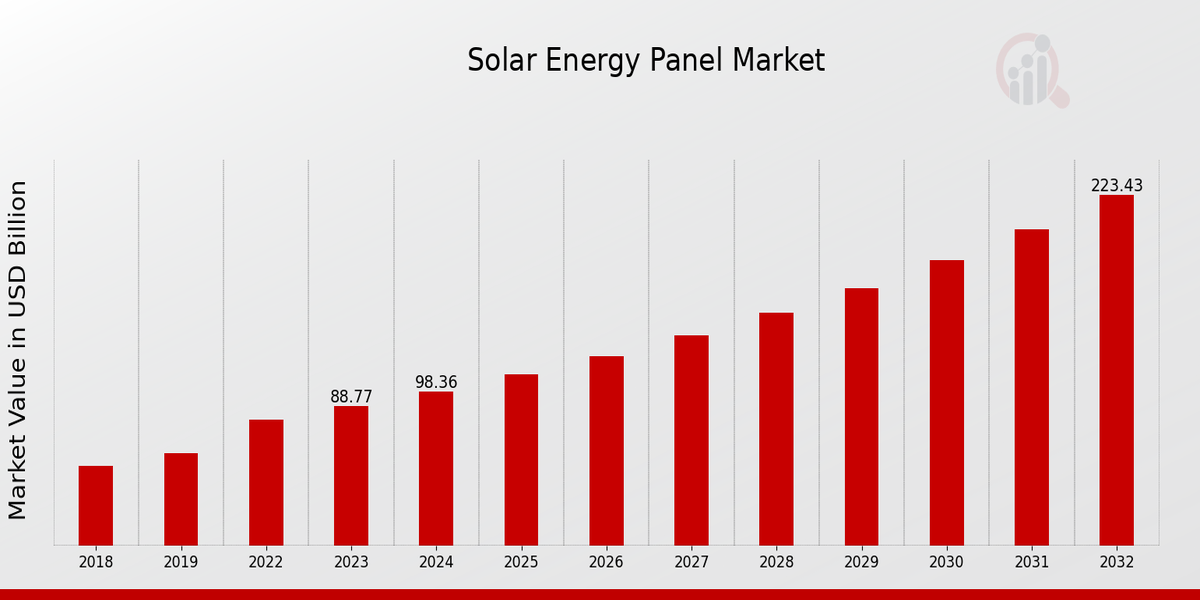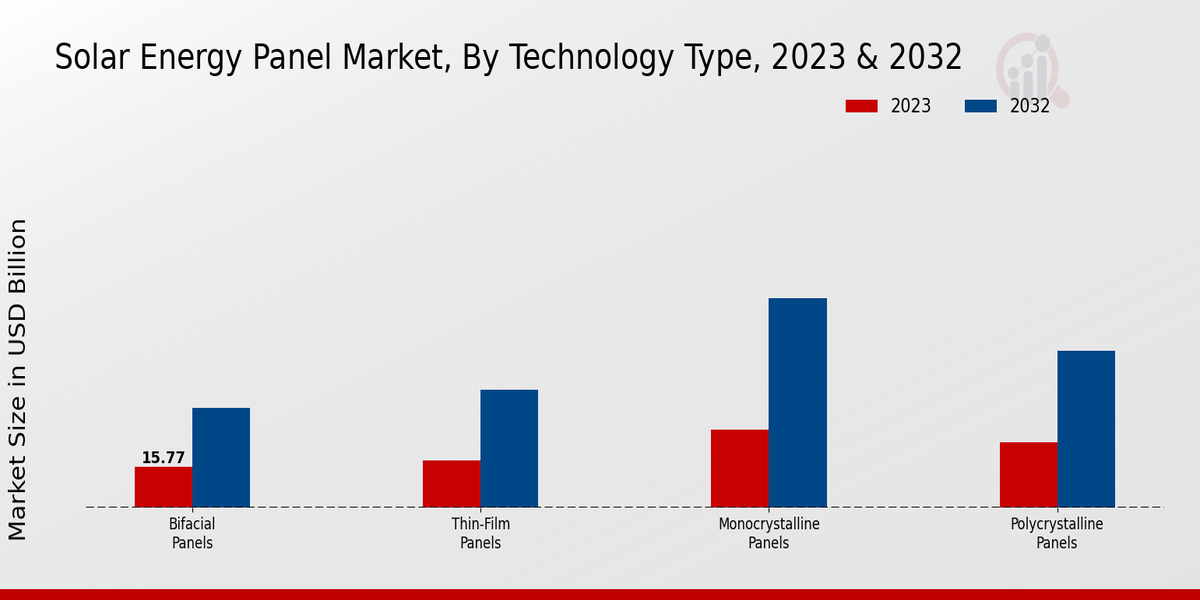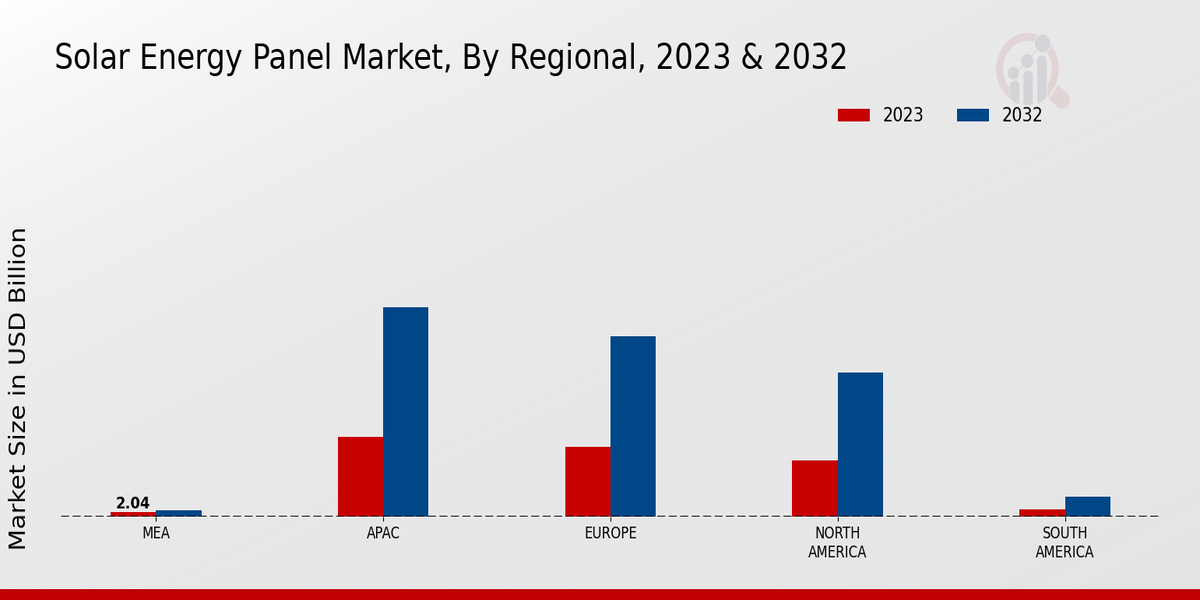Solar Energy Panel Market Overview
As per MRFR analysis, the Solar Energy Panel Market Size was estimated at 80.12 (USD Billion) in 2022. The Solar Energy Panel Market Industry is expected to grow from 88.77(USD Billion) in 2023 to 223.3 (USD Billion) by 2032. The Solar Energy Panel Market CAGR (growth rate) is expected to be around 10.8% during the forecast period (2024 - 2032).
Key Solar Energy Panel Market Trends Highlighted
The Solar Energy Panel Market is significantly driven by the increasing emphasis on renewable energy sources and the urgent need to reduce carbon emissions. Government policies and incentives aimed at promoting clean energy adoption have created a favorable environment for solar energy solutions. The declining cost of solar panels, coupled with advancements in technology, has further bolstered market growth by making solar solutions more affordable and accessible to both residential and commercial users. The rising awareness among consumers regarding sustainability and energy independence also plays a crucial role in driving demand.There are numerous opportunities yet to be explored within the solar energy panel market. As emerging economies ramp up their energy consumption, there is a growing potential for solar energy installations, particularly in regions with abundant sunlight. The integration of energy storage systems alongside solar panels enhances their viability, promoting the development of hybrid solutions that can cater to diverse energy needs. Furthermore, innovations in solar technology, such as improvements in efficiency and the development of building-integrated photovoltaics, present avenues for market players to differentiate their offerings and capture new consumer segments.In recent times, there has been a notable trend towards sustainability, prompting companies to adopt eco-friendly manufacturing processes and materials. The shift towards smart technology integration in solar panels allows users to monitor energy production and consumption more effectively, enhancing efficiency and user experience. This push for technological advancements aligns with the overall trend of digitalization in the energy sector, where smart grids and connected devices are becoming more prevalent. The combination of increasing sustainability awareness and advancements in technology is expected to drive the solar energy panel market towards a more resilient and innovative future.

Source Primary Research, Secondary Research, MRFR Database and Analyst Review
Solar Energy Panel Market Drivers
Increasing Global Energy Demand
The Solar Energy Panel Market Industry is experiencing significant growth largely due to the increasing global energy demand. As populations rise and economies expand, the need for energy continues to escalate, placing immense pressure on traditional energy sources. With growing awareness around the adverse effects of fossil fuels on the environment and climate change, there is a pivotal shift towards sustainable energy solutions. Solar energy, known for being a clean and renewable source, presents an ideal alternative.The expected growth trajectory for the Solar Energy Panel Market reflects a collective response to this rising energy requirement as more consumers and businesses seek to invest in solar panels for their electricity needs. Furthermore, the push for energy independence in various countries propels investments in solar technologies, driving the market forward. Technological advancements also play a crucial role here, with improvements in solar panel efficiency and cost reductions making solar energy more accessible than ever.This shift towards solar is not just limited to residential use, as commercial and industrial sectors are also increasingly adopting solar energy solutions as part of their energy mix. In the context of global sustainability goals and frameworks, the urgency to adopt renewable energy sources continues to amplify, thereby making the Solar Energy Panel Market a critical player in the energy arena.
Government Incentives and Policies
Government incentives and policies play a pivotal role in advancing the Solar Energy Panel Market Industry. Many governments worldwide are introducing regulations and financial incentives, such as tax credits, rebates, and feed-in tariffs, to promote the adoption of solar energy. These policies significantly lower the initial investment barriers for consumers and businesses looking to install solar panels, encouraging widespread adoption. Additionally, the commitment to carbon neutrality and sustainable development goals enhances the attractiveness of solar power as a clean energy source, stimulating market growth.
Technological Advancements
Rapid technological advancements in solar panel technology are significantly impacting the Solar Energy Panel Market Industry. Innovations such as higher-efficiency solar cells, improved energy storage solutions, and smarter energy management systems are enhancing the performance and reliability of solar panels. As the efficiency of solar panels improves, they require less space for the same amount of energy output, making them more appealing for both residential and commercial applications.Solar Energy Panel Market Segment Insights
Solar Energy Panel Market Technology Type Insights
The Solar Energy Panel Market segmentation by Technology Type reveals several key components contributing to the overall landscape of the market. For the year 2023, the Monocrystalline Panels dominated the market with a valuation of 30.0 USD Billion, showcasing their significant adoption due to higher efficiency rates and space optimization in energy production. Following closely is the Polycrystalline Panels segment, valued at 25.0 USD Billion in the same year. This technology, while generally less efficient than Monocrystalline, presents a cost-effective solution for a variety of applications, making it a popular choice among consumers. The Thin-Film Panels segment achieved a valuation of 18.0 USD Billion, primarily favored for their lightweight and flexible applications, catering to niche markets such as building-integrated photovoltaics.
Meanwhile, Bifacial Panels stand out with a valuation of 15.77 USD Billion for 2023, capitalizing on the growth of dual-sided energy capture technology that allows for enhanced efficiency by utilizing sunlight reflected from the ground. As we project toward 2032, the market shows promising growth trajectories across these technologies. Monocrystalline Panels are expected to ascend to a valuation of 80.0 USD Billion, driven by their performance capability in limited space and escalating demand for solar energy efficiency. Polycrystalline Panels are forecasted to increase to 60.0 USD Billion, remaining a favored option due to their reliable production at a competitive price point. Thin-film panels are anticipated to grow to 45.0 USD Billion, unlocking advancements in technology that improve efficiency and broaden their application spectrum. Finally, Bifacial Panels are expected to surge to a valuation of 38.3 USD Billion, achieving a large majority holding as they leverage the benefits of capturing light from both sides, marking them as a favorable alternative for solar installations in open fields or urban environments. The Solar Energy Panel Market revenue reflects a consistent demand for these technologies, driven largely by environmental policies, technological advancements, and decreasing costs of solar energy systems. Challenges in the sector, such as initial installation costs and land use disputes, continue to present hurdles, yet ongoing innovations and economies of scale are likely to create expansive opportunities for growth. As the market dynamics evolve, the insights drawn from the Solar Energy Panel Market data indicate a promising future where market players can capitalize on the growing adoption of solar technologies to meet renewable energy goals worldwide. The continued research and development efforts in enhancing solar panel efficiency, affordability, and utility will likely dictate the competitive landscape and market statistics in the years to come.

Source Primary Research, Secondary Research, MRFR Database and Analyst Review
Solar Energy Panel Market Application Area Insights
The Solar Energy Panel Market is set to experience significant growth across various application areas, including Residential, Commercial, Industrial, and Utility-Scale. In 2023, the market was valued at 88.77 billion USD, reflecting a strong commitment to sustainable energy solutions. The Residential segment plays a vital role as more homeowners seek to reduce energy costs and increase energy independence, driving demand for solar panels. The Commercial segment also shows notable vitality, with businesses striving for sustainability and benefiting from lower operational expenses through solar energy adoption.Industrial applications dominate a substantial share of the market as companies capitalize on regulatory incentives and energy efficiency measures. Lastly, the Utility-Scale segment is pivotal in meeting large-scale energy needs, providing a significant boost to the Solar Energy Panel Market statistics. The alignment of government policies and market growth drivers, such as technological advancements and increased environmental awareness, enhances the sector's potential, while challenges like space constraints and initial investment costs exist.
Solar Energy Panel Market Panel Size Insights
The Solar Energy Panel Market, valued at 88.77 USD billion in 2023, demonstrates a robust landscape for the Panel Size segment. This market is intricately segmented into Small Scale, Medium Scale, and Large-Scale categories, which cater to diverse energy needs. Small-scale panels, often utilized in residential settings, are pivotal as they provide accessible solutions for homeowners, promoting sustainable energy adoption. Medium Scale panels typically serve both commercial and industrial applications, reflecting a significant portion of market demand due to their balanced power output and efficiency.Meanwhile, Large-scale panels dominate the utility sector, supporting large solar farms and playing a crucial role in the transition towards renewable energy sources. This segment's significance is enhanced by growing energy regulations and the global push for sustainable alternatives, which create favorable conditions for the expansion of solar technologies. Consequently, the Solar Energy Panel Market statistics indicate that panel size not only influences adoption rates but also shapes the industry's growth trajectory in the coming years, paving the way for innovations and investments in renewable energy infrastructure.
Solar Energy Panel Market Installation Type Insights
The Solar Energy Panel Market, valued at approximately 88.77 billion USD in 2023, encompasses various installation types, including Roof Mount, Ground Mount, and Building Integrated Photovoltaics (BIPV). Roof Mount systems are increasingly popular due to their space efficiency and ease of installation on residential and commercial rooftops, providing a significant share of the market. Ground Mount systems cater to larger energy needs, often installed in utility-scale projects, and continue to demonstrate substantial growth driven by the need for clean energy solutions.BIPV has emerged as a significant trend, integrating solar panels into building materials supporting aesthetic and functional architectural designs, thereby promoting sustainability. The interplay between these installation types shapes the Solar Energy Panel Market segmentation, with market growth supported by technological advancements and rising demand for renewable energy solutions. Despite facing challenges such as initial installation costs and regulatory hurdles, the overall landscape offers numerous opportunities, with a growing emphasis on eco-friendly energy practices driving investment and innovation in the industry.
Solar Energy Panel Market End User Insights
The Solar Energy Panel Market is poised for substantial growth, driven by diverse end users encompassing Private Households, Small Businesses, Large Enterprises, and Government Institutions. By 2023, the market was valued at 88.77 billion USD, reflecting the increasing adoption of renewable energy solutions. The Private Households segment is becoming increasingly significant due to rising energy costs and the pursuit of energy independence. Small Businesses are also contributing notably, adopting solar energy to lower operational costs and enhance sustainability practices.Large Enterprises are dominant players, deploying advanced solar technologies for extensive energy savings and favorable public perception. Government Institutions play a crucial role through initiatives and policies that promote solar adoption, leading to significant investments in solar infrastructure. Trends indicate a concerted effort across these segments to transition towards sustainable energy, supported by various growth drivers such as technological advancements and favorable regulatory frameworks. However, challenges like initial investment costs and space limitations continue to impact widespread adoption.
Solar Energy Panel Market Regional Insights
The Solar Energy Panel Market has shown promising trends across various regions, with a total market value of 88.77 USD Billion in 2023. The Asia-Pacific region dominates the market with a value of 31.84 USD Billion, holding a majority of the share due to its rapid industrialization and the increasing demand for clean energy solutions. Europe follows closely, valued at 28.01 USD Billion, supported by strong governmental policies promoting renewable energy. North America contributes significantly, with a valuation of 22.75 USD Billion, benefiting from technological advancements and incentives for solar energy adoption.In contrast, the South American market is valued at 3.13 USD Billion, indicating potential for growth as countries seek sustainable energy sources. The Middle East and Africa, valued at 2.04 USD Billion, represent emerging opportunities driven by rising investments in solar infrastructure. The industry's growth is propelled by increasing environmental concerns, high energy costs, and supportive government regulations, although challenges such as high initial investment costs and limited awareness persist. Overall, the Solar Energy Panel Market segmentation reveals significant potential for expansion and investment within these regional markets.

Source Primary Research, Secondary Research, MRFR Database and Analyst Review
Solar Energy Panel Market Key Players And Competitive Insights
The Solar Energy Panel Market has experienced significant growth and transformation, driven by an increasing demand for renewable energy sources and advancements in solar technology. This competitive landscape is characterized by a diverse range of players, from established multinational corporations to emerging innovators, all vying for market share in an environment marked by rapid technological advancements and shifting consumer preferences.
GCLPoly Energy stands out in the Solar Energy Panel Market due to its strong commitment to research and development, enabling the company to innovate and offer high-performance solar panels continually. Its extensive manufacturing capabilities give GCLPoly Energy a significant advantage, allowing for cost-effective production while maintaining quality standards that meet international certifications. The company has cultivated strong relationships across the supply chain, ensuring a steady flow of raw materials and enhancing its production efficiency. GCLPoly Energy has also actively engaged in various partnerships and collaborations aimed at expanding its reach in global markets. As a result, the company has established a formidable presence in key regions, effectively leveraging its strengths to capture an increasing share of the burgeoning demand for solar energy solutions.Trina Solar plays a pivotal role in the competitive landscape of the Solar Energy Panel Market, recognized for its innovative technology and high-quality products. The company has made significant strides in advancing solar panel efficiency and performance, thereby enhancing its competitive position. Trina Solar's strong focus on sustainability is reflected in its comprehensive product range, which includes residential, commercial, and utility-scale solar solutions, catering to a diverse customer base. The company's extensive global network and strategic partnerships have enabled it to penetrate various markets effectively, amplifying its brand presence.
Key Companies in the Solar Energy Panel Market Include
Solar Energy Panel Market Industry Developments
Recent developments in the Solar Energy Panel Market indicate a significant push towards sustainable energy solutions as governments and companies prioritize carbon neutrality. Innovations in photovoltaic technology continue to enhance efficiency and lower production costs, making solar panels more accessible to a broader audience. Major investments in research and development are being observed, particularly in the areas of battery storage and grid integration, addressing challenges associated with solar energy's intermittent nature. Regulatory frameworks and incentives in various countries are being updated to facilitate the adoption of solar energy, and key players are expanding their manufacturing capabilities to meet growing demand. Furthermore, collaborations between technology firms and traditional energy companies are becoming increasingly common, aiming to accelerate the transition to renewable energy sources.
Solar Energy Panel Market Segmentation Insights
- Solar Energy Panel Market Technology Type Outlook
- Solar Energy Panel Market Application Area Outlook
- Solar Energy Panel Market Panel Size Outlook
- Medium Scale (251W to 400W)
- Solar Energy Panel Market Installation Type Outlook
- Building Integrated Photovoltaics (BIPV)
- Solar Energy Panel Market End User Outlook
- Solar Energy Panel Market Regional Outlook
| Report Attribute/Metric |
Details |
| Market Size 2022 |
80.12(USD Billion) |
| Market Size 2023 |
88.77(USD Billion) |
| Market Size 2032 |
223.3(USD Billion) |
| Compound Annual Growth Rate (CAGR) |
10.8% (2024 - 2032) |
| Report Coverage |
Revenue Forecast, Competitive Landscape, Growth Factors, and Trends |
| Base Year |
2023 |
| Market Forecast Period |
2024 - 2032 |
| Historical Data |
2019 - 2022 |
| Market Forecast Units |
USD Billion |
| Key Companies Profiled |
GCLPoly Energy, Trina Solar, First Solar, SunPower, JA Solar, Seraphim Solar, JinkoSolar, Talesun Solar, Risen Energy, LONGi Green Energy, China Yangtze Power, Siliken, Qingdao Zhongkang, Canadian Solar, Hanwha Q CELLS |
| Segments Covered |
Technology Type, Application Area, Panel Size, Installation Type, End User, Regional |
| Key Market Opportunities |
1. Rising demand for renewable energy 2. Government incentives and subsidies 3. Technological advancements in efficiency 4. Increasing residential solar installations 5. Expansion in emerging markets |
| Key Market Dynamics |
1. Rising energy demand 2. Government incentives 3. Technological advancements 4. Environmental concerns 5. Cost reduction strategies |
| Countries Covered |
North America, Europe, APAC, South America, MEA |
Frequently Asked Questions (FAQ) :
The Solar Energy Panel Market is expected to be valued at 223.3 billion USD by 2032.
The expected CAGR for the Solar Energy Panel Market from 2024 to 2032 is 10.8%.
The APAC region is projected to have the largest market size in the Solar Energy Panel Market, valued at 83.78 billion USD by 2032.
The market size of Monocrystalline Panels is expected to reach 80.0 billion USD by 2032.
Major players in the Solar Energy Panel Market include GCLPoly Energy, Trina Solar, First Solar, and JinkoSolar.
The market value of Polycrystalline Panels is expected to reach 60.0 billion USD by 2032.

















